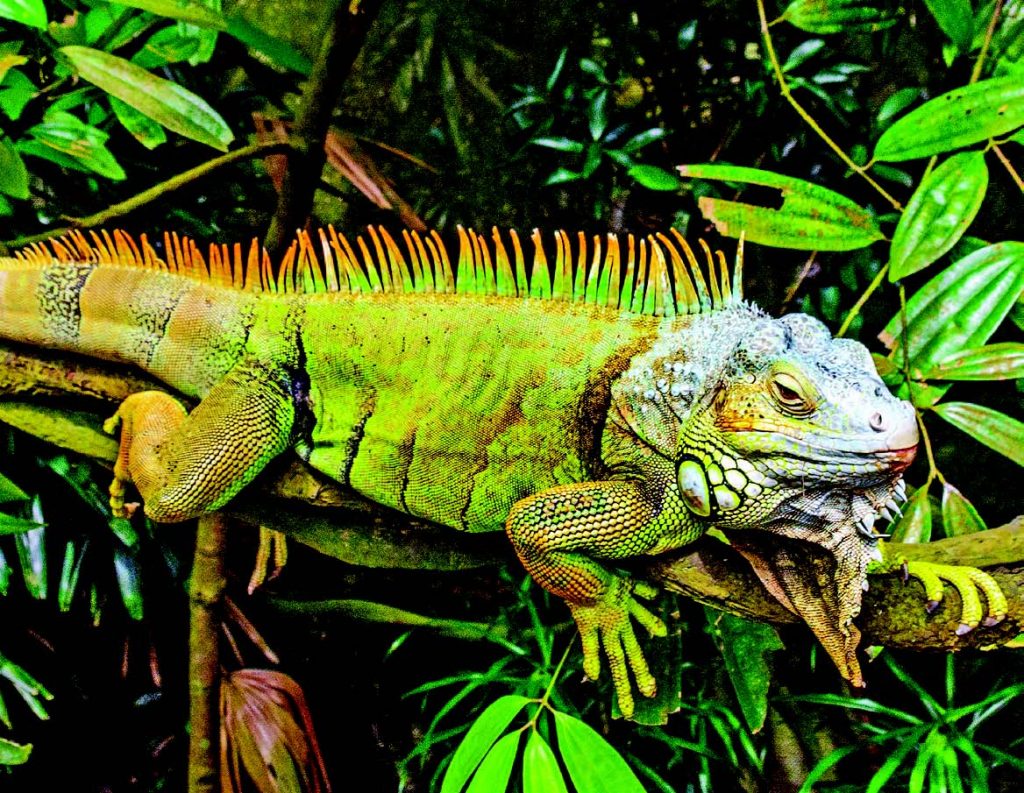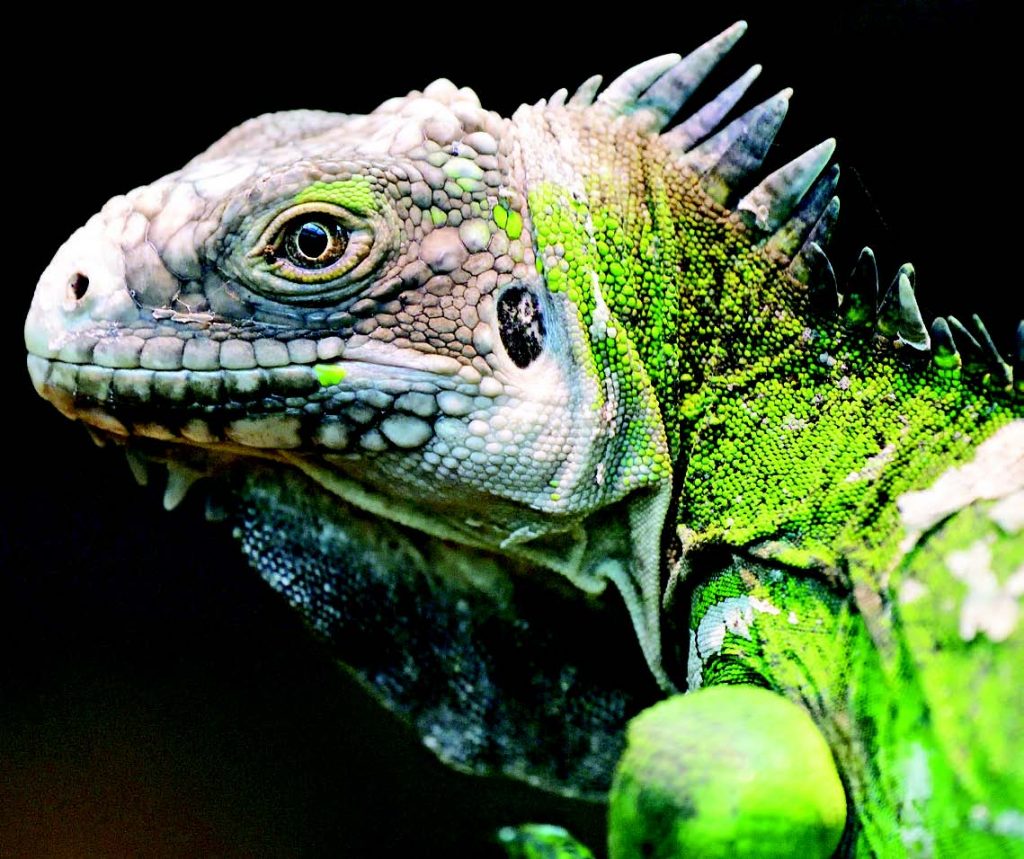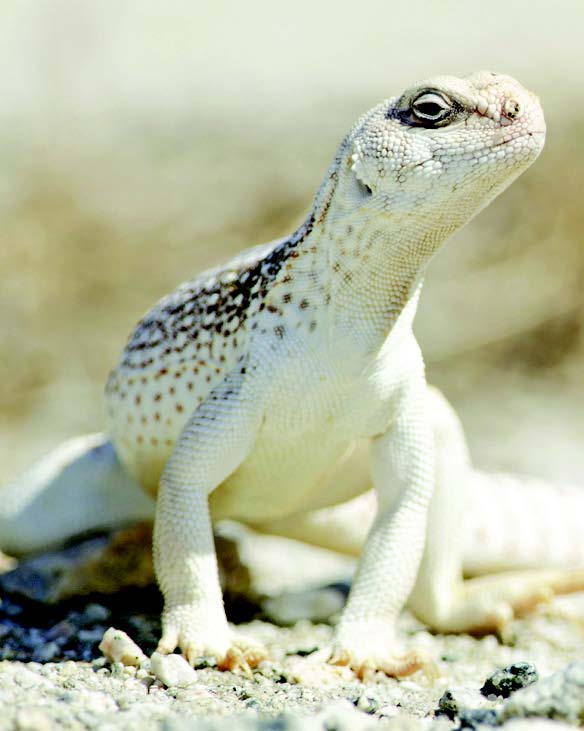From the highest trees to the hottest deserts, and quite surprisingly even in the deep blue seas, iguanas are hardy reptiles in all sorts of shapes and sizes, each with their own individual characteristics.
Let’s explore a few known iguanas around the world. It’s important to note that not all iguanas mentioned here are suitable as animal companions: Some of them are endangered or unsuitable for a captive life.
1. Common iguana
Scientific name: Iguana iguana
Location: Central America, Northern Mexico, Caribbean Islands & Southern Brazil
Habitat: Humid environments like rainforests, often seen resting on treetops near bodies of water

One of the most popular reptiles to keep in captivity, these arboreal lizards are common pets around the world and come in a variety of colors, such as red, blue, yellow, green, white, and even orange. Despite their popularity, they aren’t suitable for beginner reptile hobbyists – they tend to become dangerously aggressive when not properly acclimated.
They are also one of the largest iguanas in the world, capable of growing up to 6 feet in length, so imagine how difficult it would be to keep them as pets.
Naturally located around Central America, the Iguana iguana has unfortunately started to become an invasive species in many countries around the world due to an increasing number of people releasing them into the wild after realizing how difficult they are to keep as pets. This not only disrupts the environment, but also becomes a threat to all the other flora and fauna living there.
2. Rock Iguana
Scientific name: Cyclura
Location: Cuba, Cayman Islands, Bahamas, Jamaica, Haiti, Dominican Republic, etc.
Habitat: Subtropical, rocky, dry savannah
Cyclura is an umbrella term for iguanas in the Cyclura genus. Pertaining to ground iguanas, there are different kinds under this category, such as the Rhinoceros iguana (Cyclura cornuta), Blue Grand Cayman iguanas (Cyclura lewisi), Cuban rock iguana (Cyclura nubila), and Jamaican rock iguana (Cyclura collei).

These guys are capable of living from 20 to 70 years and thrive on a predominantly vegetarian diet. They prefer very high temperatures to bask in, even as hatchlings. Compared to the Iguana iguana, rock iguanas typically don’t have the large scale (subtympanic shield) on the jowl or spikes on the dewlap, nor do they have smooth tails. They are also visibly much larger and bulkier and are capable of surviving longer without water.
3. Marine Iguana
Scientific name: Amblyrhynchus cristatus
Location: Galapagos Islands
Habitat: Rocky cliffs and ledges with near access to the ocean
Probably one of the most fascinating iguanas on the list, these flat-nosed, wide-eyed Godzilla-like creatures are the only known lizards to swim and feed underwater.

Also known as saltwater iguanas, marine iguanas use their powerful tails to propel their bodies flawlessly through water to feed on algae found on rocks at the bottom of the sea. On land, however, they are rather clumsy.
Their flat faces are packed with razor sharp teeth that make it easier for them to scrape off food from different surfaces. With salt-crusted heads and dark grey bodies that can easily absorb light, the marine iguanas are believed to have originally been land iguanas that drifted on to the Galapagos islands where they eventually evolved and adapted. As of now, these scaly mermaids are highly protected since they are estimated to be few in number and have been known to exclusively reside around the Galapagos island.
4. Lesser Antillean Iguana
Scientific name: Iguana delicatissim
Location: Lesser Antilles islands near the Carribean sea
Habitat: Moist tropical forests, scrub, and woodlands
Found mostly around the Lesser Antilles Island, these arboreal iguanas look strikingly similar to their green Iguana iguana cousins. However, they do have a set of distinct physical characteristics.

For one, Iguana delicatissima doesn’t have a subtympanic shield, the large scale on their lower jowls, nor do they have black or brown stripes on their tails. And unlike the common iguana, adult male lesser Antillean iguanas turn dark grey as they reach sexual maturity and later develop light blue and pinkish scales around their head during breeding season. Iguana iguanas, on the other hand, turn into an orangey hue during this time. Sexually mature females turn a brighter green color just like their cousins.
Sadly, like many of the iguanas on the list, the Iguana delicatissima is considered critically endangered due to the destruction of natural habitats, accidental road kills, feral predators, and the terrorization of invasive green iguanas. Because the common green iguanas and the lesser Antillean iguanas are so similar, they inter-breed, producing “impure” hybrids that threaten the genetically “pure” population.
5. Desert Iguana
Scientific name: Dipsosaurus dorsalis
Location: Arizona, Sonoran, and Mojave deserts, and several gulfs of on the California islands
Habitat: Desert with a bit of vegetation like shrubs
With a predominantly white and brown camouflage pattern, desert iguanas blend almost perfectly with their environment and use their smooth bellies to glide through the hot sand and into burrows to escape predators. Partially arboreal omnivores, they are usually found munching on the yellow flowers of the low shrubs known as creosote bushes and occasionally any bugs they happen to come across.

With a general life expectancy of around 7 to 14 years, the Dipsosaurus dorsalis have the ability to change color to help regulate their temperature, turning dark during the early morning to absorb heat and then a lighter shade during the early afternoon to reflect sunlight.
6. Spiny-tailed Iguana
Scientific name: Ctenosaura similis
Location: Mexico and Central America
Habitat: Hot and dry rocky environments
Known as the fastest lizards in the world, running at 34 kilometers per hour, these dinosaur-like iguanas are terrestrial in nature but are also capable of skillfully climbing up trees and other high places if needed. Capable of growing to 3 to 4 feet, the spiny-tailed iguana gets its name from the sharp, barb-like spines found on its powerful tail used to ward of predators.

Although generally dark gray, or black and white as adults, hatchlings start off as bright green and gradually lose their color as time goes by. As juveniles, they tend to be insectivorous, feeding on worms and bugs, but later become pure herbivores, devouring flowers and fruits.
7. Fiji banded Iguana
Scientific name: Brachylophus fasciatus
Location: Fiji, South pacific
Habitat: Wet forests
These gorgeous arboreal emerald iguanas are a sight to behold. The males of this species are endowed with brilliant blue and light green stripes, while the females are usually a solid green with the occasional white and blue patches across their bodies. Both sexes sport yellow nostrils and underbellies.

Sensitive to light, Fiji iguanas are considered endangered due to habitat loss, poaching, and invasive predators. They are therefore protected by the Fijian government and are considered a national treasure. What makes matters more difficult for their species is that they are known to only lay around 3 to 7 eggs per clutch annually and their incubation period lasts a staggering 9 months to hatch, making them quite rare.
There are a good number of Iguana species around the world with their own subcategories and the list could go on and on. Not all are suitable as pets – sadly, some species are dwindling in population due to various reasons, including climate change and illegal poaching.
Not all hope is lost, thanks to some reptile facilities that started breeding endangered iguanas in captivity to get their numbers up.
Iguanas are fascinating reptiles and are incredibly fun to study. I highly encourage people to learn more about them and protect them, not just as pets or as part of a reptile collection, but also as beautiful animals whom we need to respect and save from extinction.
This appeared in Animal Scene Magazine’s July 2019 issue.
Related stories:
– Florida homeowners are now allowed to kill iguanas
– Inside an iguana: Basic anatomy
– Iggies 101: What you need to know before welcoming an iguana into your home






